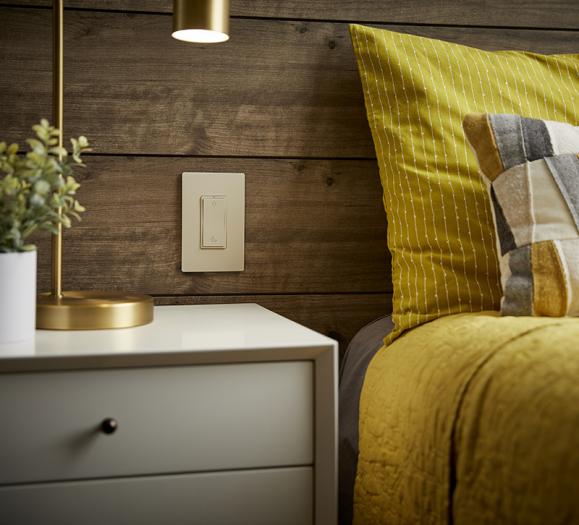Smart lighting, appliances and more have one thing in common. They need to connect to Wifi or Bluetooth to enable smart functionality — i.e., turning the lights on and off via an app on your phone or asking Alexa to start the shower at the exact temperature and pressure you prefer. Without this connectivity, smart functionality just isn’t smart enough.
As consumers continue to become more aware of and embrace smart functionality, whether for safety, convenience or efficiency, it has become even more important to create connectability that works within the framework of existing homes and their electrical systems.
“Seventy-four percent of households own smart devices today,” says Desiree Webster, Strategic Product Manager, IoT for Legrand. “That’s a staggering number. Of those households, on average, they plan on adding an additional eight smart devices in the next 12 months.”
While we’re adopting smart devices in our homes at a record pace — think phones, tablets, TVs and camera doorbells for starters — the term gives the impression that connecting these products is going to be more complex than plugging in a traditional device.
However, as with the connecting portion of a lightbulb, which hasn’t changed in a century, wiring for outlets, switches and overhead lights have remained unchanged for decades as well. How do we take our existing framework and make it smart? Legrand and SKYX Platform have some novel ideas.
Switching It Up
Recently, fashion switch and outlet manufacturer Legrand purchased Netatmo technology — the term combines the words network and atmosphere. Originating in France, Netatmo allows switches and outlets to talk to each other and a Wifi-enabled hub through a mesh network that connects all Netatmo-enabled switches and outlets. The technology, while relatively new in the U.S., has been considered the “Nest” of Europe, Legrand notes, as the platform has employed its smart networking capabilities in thermostats, air quality and HVAC systems, and more.
Legrand has added Netatmo to its switch and outlet systems, such as adorne and radiant. Once installed, the switching systems that control lighting, appliances and anything else turned on at that junction are now smart, giving the homeowner the ability to control those appliances and fixtures from any number of connections, including a smart phone, Alexa or the switches themselves.
Netatmo uses zigbee, a standards-based wireless technology developed to enable low-cost, low-power wireless machine-to-machine (M2M) and internet of things (IoT) networks, to connect its switches and outlets to each other and then a hub that connects to Wifi.
“Wifi takes a lot of power but doesn’t give a lot of distance,” Webster notes. “Lights have to be turned on and off. That can’t be relevant based on whether you have the Wifi bandwidth.” The zigbee network eliminates that issue, as each switch and outlet installed connect to each other rather than directly to the Wifi signal in the home. The more switches and outlets in place, the stronger the signal becomes within this network, Webster continues. The hub itself replaces an existing switch or outlet for a discreet hub and smart lighting control.
Replacing outlets and switches with Legrand’s Netatmo switches and outlets works with the existing electrical system as well. “Because we build the ‘smart’ into the design, you can’t tell the difference [between a Netatmo switch or a regular switch],” says Webster. “You see switches that look beautiful together.”
These products wire in as any outlet or switch system would, eliminating the need for extensive electrical work in the home and maintaining the aesthetic of switches throughout the space. Also, more switches can be added without any wiring to add convenient placement where switches might be needed. Because the switches connect through Netatmo’s mesh system, these added switches can be adhered to the wall and don’t require additional wiring. They can be directed to control whichever lights and appliances necessary via the app.
The app, too, simplifies the process of setting up the network and the appliances and lights the switches talk to, and also allows the homeowner to customize the app to their preferences — no technicians needed.
“You can control anything connected to a Netatmo outlet or switch through the app,” says Webster. “That’s the value of smart products in general. Consumers really need to think through the right value proposition for them.”
For some consumers, being able to use just the switches in the home works for them, for example. If away from the home, however, you still have the ability to schedule lights to go on and off, helping with security and energy efficiency. The Netatmo app monitors the electricity in the home as well and sends alerts during power outages. “You want to know when the power glitches,” Webster notes, especially if outages last longer and appliances such as refrigerators and wine coolers might be impacted.
“Lighting control is not a new concept. It is one of the things that rates high on consumer wish lists,” Webster says. As consumers become more comfortable with smart technology and are looking for security, ways to reduce energy usage, and simplifying turning lights and other appliances on and off, Legrand’s Netatmo system continues to find placement in more and more homes. Easy to install and use, customizable for each person’s needs, no strain on current Wifi systems and the ability to set and then monitor usage continues to deliver value to consumers adopting Legrand’s Netatmo system. “It’s about offering smart choices,” Webster says. “We don’t want things that take more effort. We want to set it and forget it.” That’s something that Netatmo simplifies and makes even more desirable for consumers interested in bringing smart technology home.
Hovering Overhead
Keeping with the focus of simplifying smart technology for the average consumer, SKYX Platform debuted its smart SkyXPlug technology this January, garnering awards at CES and significant buzz at Lightovation and KBIS. The SkyXPlug follows the success of SkyPlug, which offers a safer and easier way to attach lighting and fans to ceiling junctions. The new Smart canopy, which will be available in several months, attaches to the SkyPlug ceiling connection base. Wifi- or Bluetooth-enabled, it includes such functionality as speakers, smoke and CO2 detectors, emergency lighting, dimming, night light and color-changing capabilities. It turns traditional fixtures and bulbs into smart fixtures which can then be controlled by an app on the phone or tablet or voice-activated platforms.
Like Legrand’s Netatmo switching system, SKYX canopies are designed to integrate seamlessly with existing wiring and fixtures, simplifying the installation process for homeowners and building professionals. ”Our mission is to make homes safe and smart,” says Rani Kohen, Founder of the company and inventor of the technology.
The first canopy, SkyPlug can be connected to electrical ceiling junctions, eliminating the need to climb ladders with lighting fixtures to install. Lighting fixtures can then be installed with a click into the SkyPlug canopy, eliminating the need to rewire everytime a fixture is changed. To obtain a certificate of occupancy on new building, lighting needs to be installed in the ceilings of rooms and hallways, Kohen notes. Skyplug replaces the need for fixtures to be in place, saving time and money for building professionals. It’s also a safer installation as it doesn’t have the weight or bulkiness of lighting fixtures. When fixtures are ready to install, they click into place, no additional wiring needed. “This is the most significant addition [to lighting installation] in 40 years,” Kohen says.
As consumers and builders become more aware of the advantages of SkyPlug, it’s adoption continues to grow. And now with it’s smart SkyXPlug canopy, which also clicks into the base, connected lighting fixtures take on smart properties and can be controlled by voice-enabled technology, or via apps on phones and other devices. In addition to the built-in smart features in the canopy — changing light, safety detectors and speakers, for example — adding a Wifi connection in the ceiling is optimal for that signal to be evenly distributed around the room, says Kohen. “There is almost unlimited electronic real estate on that ceiling. Everything [connected to Wifi] will work better because that’s the best location,” he says.
While the SkyPlug and SkyXPlug were designed first for safety and ease of use, adding smart functionality will allow consumers to control any SkyXPlug-enabled fixtures to be controlled via the same app.
Smart, safe and simple, the SkyPlug and SkyXPlug are ripe to change the way lighting fixtures are installed in new construction and existing homes. The canopies are retrofitted to work with existing electric installation and provide a seamless upgrade that has the ability to enhance lighting’s functionality







